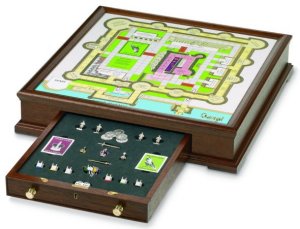 Last week I got to play a game for the first time that just bowled me over with the quality of its presentation. This isn’t about overproduction, or artwork, just a simple appreciation that laid out on the table in active play the thing was a veritable feast for the senses, a smorgasbord of texture, colour and sculpture.
Last week I got to play a game for the first time that just bowled me over with the quality of its presentation. This isn’t about overproduction, or artwork, just a simple appreciation that laid out on the table in active play the thing was a veritable feast for the senses, a smorgasbord of texture, colour and sculpture.
So it inspired me to have think about what my favourite looking games of all time were. What titles draw admiring looks from gamers and non-gamers alike when they’re laid out of the table and being played in a flurry of dice, cards and activity. So I made a top five which I’m about to count down for you. In doing so it has to be said that I’ve simply ignored all the massively priced collectors games and whatnot that would obviously dominate this list if not left out. Things like theWar of the Ringcollector’s edition, or the deluxe hand-carved and jewel-encrusted editions of popular games likeMonopoly andOutragethat can sell for hundreds, if not thousands. No, we’re sticking to mass-produced games here that can (or could) be bought for prices in line with the vast majority of hobby games already on the market.
And remember, this is my list, my choices and this is about aesthetic appreciation which isn’t amenable to facts or even resolute debate. Feel free to disagree, that’s what the comments section is at the end for, because I suspect my number one choice isn’t going to be popular. And neither is the one I’m opening with.
But before we get to that I have to cover a glaring omission in order to head off the people who’ll wonder why certain games are not here: there are no Games Workshop games amongst my picks.Space Hulk has production value coming out the wazoo but it basically just wasn’t to my taste. I thought that although the embossed tiles were fantastic and super-chunky, there wasn’t enough uniformity in the board art: every single door being different? That just looks odd. And again although the miniature sculpts were beautifully detailed, I don’t like the new gothic space marine look, and I didn’t like the way the genestealers were moulded on to the scenery. Pillars don’t move around, you know.Dreadfleet looks fantastic from a miniatures gamers point of view but unpainted it looks a lot less spectacular, thanks to its relatively plain board and cards. And seeing as painting is an optional extra I can’t consider that as part of the qualifying criteria.
5. Last Night On Earth

It’s a divisive one, certainly, but you can’t argue that Flying Frog’s approach to board game art with its actors, make-up and staged photo shoots isn’t unique. I’d also argue that for every other game in their line up it’s been a flop. The people in hairy rubber masks that masquerade as monsters inA Touch of Evil just look stupid - it’s pushing the envelope too far to expect to make a scary vampire on a board game production budget. But to make a good zombie you just need a bit of face paint and here’s where theLast Night On Earth artwork really shines: it makes the game look just like the zombie films it strives to emulate. It’s not an approach that’s either applicable of functional for most genres, but for zombies, it’s damn perfect. It helps a lot that the game also has a ton of excellent plastic sculpts including various poses of zombies and unique sculpts for all the heroes.
4. War of the Ring
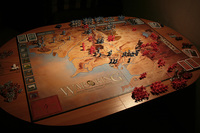
So I dismissed the Collector’s Edition early on in this piece but let’s face it, the basic package was damn spectacular as it was. Which you prefer, the board and card art in both editions is striking and spectacular, and when you lay the quite ridiculous numbers of plastic figures on the top the whole effect is mind boggling. I don’t know any other game that quite gives the viewer such a sense of titanic forces clashing, let alone manage to do so in such a dynamic enthralling manner as this does, with so many different sculpts and character figures. And the icing on the cake is, of course, that this isn’t just generic fantasy: this is a god’s-eye view of all the action encapsulated in the epic and much beloved Lord of the Rings bought into life in full 3D in your very own living room.
3. Cadwallon: City of Thieves
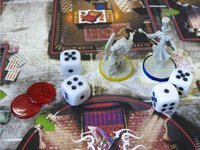
Cadwallon never seemed to catch on as a popular title and no-one ever talks about it, which is a shame because it’s a decent game with plenty of narrative and re-playability thanks to the scenarios. And also because it looks like a million dollars, something that more people might realise if it got played more often. It might not have a ton of plastic miniatures in the box, and they might be low-grade, bendy plastic but I love the fact that every sculpt is different. I also love the big bag of stamped plastic coins in sparkly bronze, silver and gold: in games with money I delight in being able to grab fistfuls of it and let it run through my fingers, and these coins are just perfect for that. But the attention grabber in this game is the stunning, jaw dropping, high-quality and amazingly imaginative art. I realise most of it was stolen from an RPG that shares the setting of this game but the style is just so rich and vibrant that I’ll happily sit and flip through the rulebook and scenario boards just to immerse myself in the art, something that no other board game makes me want to do.
2. Claustrophobia
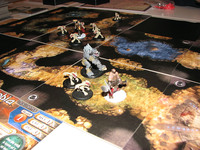
This is the game I was alluding to when I opened this list. It eats table space like a starving man would fall upon a bowl of pasta but my, don’t those oversized tiles look amazing in their chunky technicolour glory? The dark tunnels, glowing with the hellish light of the abyss and detailed with horrors such as holes into the underworld, writhing tendrils greedy for blood, flooded caverns and infernal mechanisms are hugely atmospheric. But the crowning glory here are the figures that grace them. They’re good sculpts for starters and made from good plastic that doesn’t warp and bend with use but it’s the fact they’re pre-painted that really make it. Pre-painted figures are pretty rare in board games anyway but in this quantity (17) and at this price point it’s unheard of. The card art is a bit rubbish but they’re face down most of the time. And if you’re anything like me you can barely tear your eyes away from the magnificent spectacle of the board to actually read the text of what you’re got in your hand in any case.
1. Napoleon’s Triumph
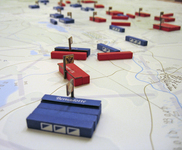
No plastic. No illustrations. Very little colour. And yet since the time I broke the shrink on this and started to lay out the components I’ve been in love with what came in the box. As a demonstration of the “less is more” maxim, it’s unrivalled. The art on the enormous board is minimalistic and functional and yet manages to be beautiful, recalling a military map in its subtle use of greys, greens and browns, occasionally interspersed with symbolism or gothic text. The long, low wooden pieces are nothing in themselves, but ranked together and topped with the metal flags used to denote a corps they seem strikingly martial. And, in demonstration of yet another maxim about the whole being greater than the sum of its parts the result looks exactly as you might expect a map of the situation laid out in the tent of a 19th century general officer to look. That precisely the effect the designer intended and it adds a magnificent dash of authenticity, authenticity you can actually reach out and touch and interact with to what’s an already deep and highly enjoyable game.